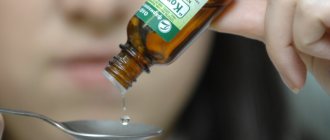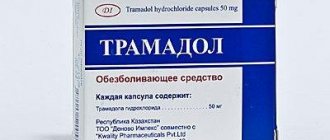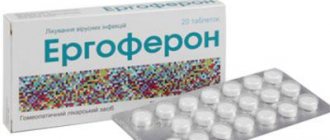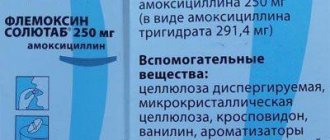People using the drug Asparkam must know the symptoms of overdose and its possible consequences.
Improper use of any drug can lead to serious consequences. Often a person himself harms his health and even poses a threat to life. This does not always happen intentionally; sometimes it is enough to miscalculate the dose and take a few more tablets - the body reacts completely unpredictably.
In order to avoid such consequences, it is important to consult a doctor before using any medicine - only a specialist can prescribe both the dosage and the correct time to take the drug, and only in this case the treatment will be effective.
An overdose of Asparkam, a drug used to treat a huge range of diseases, is quite dangerous for the human body, therefore it is important to know all the symptoms of this disease and promptly stop using the medicine when they appear.
Composition and dosage form
Release form: the drug is produced in tablets and ampoules. The color of the tablets is white, the surface is smooth. They have a specific smell, are flat, cylindrical in shape, and the line divides the tablet into 2 parts. Each blister contains 50 tablets, one blister constitutes a package. Composition of Asparkam:
- The tablet contains 0.175 g of each active ingredient.
- Corn starch.
- Calcium salt of stearic acid (stearate).
- Polysorbate-80.
The injection solution has a white or slightly yellowish color. Ampoules contain 5 or 10 ml. The injection form consists of dehydrated magnesium and potassium aspartate with a density of 40, 45.2 mg/ml, sorbitol (E420), water for injection. International name: Potassium aspartate & magnesium aspartate. INN: potassium and magnesium aspartate. Pharmacological group of the drug:
- antiarrhythmic drug;
- micro-, macroelements.
Aspartame - no more secrets
Aspartame is an artificial sweetener obtained by chemically combining aspartic acid and phenylalanine esterified with methanol . The final product appears as a white powder.
Like all other artificial sweeteners, it is designated by a special abbreviation: E951.
Aspartame tastes like regular sugar , but has a similar calorie level - 4 kcal/g . What's the difference then? It's a matter of sweetening "power" : aspartame is two hundred times sweeter than glucose , so a small amount is enough to get an absolutely sweet taste!
The maximum recommended dose of aspartame is 40 mg/kg body weight. It is much higher than what we consume during the day. However, exceeding this dose will lead to the formation of toxic metabolites, which we will discuss later in the article.
Aspartame was discovered by chemist James M. Schlatter, who was trying to develop an anti-ulcer drug. As he licked his fingers to turn the page, he noticed a surprisingly sweet taste!
Therapeutic effect
Potassium and magnesium ions provide the therapeutic effect of Asparkam. The disturbed balance or lack of magnesium with potassium will be eliminated; many biochemical reactions occur together with these ions, so metabolic processes are normalized. In internal organs and tissue structures, potassium is considered the main positive ion of intracellular structures. It activates the production of adenosine triphosphoric acid, peptides, acetylcholine with glycogen.
ATP (adenosine triphosphoric acid) is a universal energetic molecular compound; any reaction and cellular function is carried out with the help of this molecule, including nutrition and reproduction. With the help of potassium, the cell will receive a large amount of energy (ATP is synthesized), the cell will perform various functions (contraction of myofibers, synthesis of hydrochloric acid and other reactions).
Thanks to the potassium found in Asparkam, molecules will be formed to nourish the cell, protein components will begin to renew
Potassium will speed up the work of cellular structures, increase its efficiency, and the cell will have a quick response to impulses from neurons. Due to the fact that glycogen production in the cell is stimulated, a supply of nutritional components will appear, which, if necessary, will be converted into ATP. Protein production will allow the cell to promptly replace “outdated” molecules that do not function fully with updated ones that work easily and quickly.
Acetylcholine synthesis will accelerate impulse conduction through neurons, as this component activates nerve tissue. More than 300 enzyme compounds work thanks to magnesium; these enzymes are involved in metabolism and perform specific functions for each cellular structure. The magnesium element is involved in various reactions for the production of ATP, magnesium also normalizes potassium balance, enhances the effect of potassium, the cell will work efficiently and quickly.
With the help of potassium and magnesium ions, membrane polarization of cellular structures is maintained; this is necessary in order to distinguish the external environment from the internal cytoplasm of the cell. Therefore, dangerous, unnecessary compounds will not reach the cell, and metabolites will be removed from it. The medication transports potassium and magnesium ions through the membrane membrane to the cell, where they are released from the aspartate bond, and aspartate is introduced into metabolic processes.
It will improve the production of replaceable amino acid compounds, fats, and nucleotide structures for DNA. Aspartate also optimizes energy metabolism in heart tissues experiencing hypoxia during various pathological processes. Why does Asparkam need it? These effects are carried out by Asparkam in all organs and tissue structures; the drug has a particularly beneficial effect on the heart, so it should be used for:
- Prevention of potassium deficiency in the bloodstream.
- Improves metabolism in heart tissue.
- Elimination of arrhythmia caused by a heart attack due to heart failure.
- Improved tolerability of any cardiac glycoside.
- Increasing cardiac endurance, easy tolerance of strong emotions. The person will become physically resilient.
- Improved elasticity of vascular tissues, as the product thins the blood.
- Improved impulse conduction of neurons.
If you take such a remedy, the likelihood of the formation of cerebrovascular pathological processes with a fatal outcome will decrease.
The medicine is absorbed quickly and completely. Metabolic products will be eliminated due to renal function. The serum concentration of magnesium with potassium will be maximum 1-2 hours after you take the tablet. From the blood, the drug will reach the myofibers of the heart in the form of magnesium, potassium ions with aspartate, where they will also be included in metabolic processes.
Peculiarities
Aspartame is a sweetener that is many times (160-200) superior to the sweetness of sugar, which makes it popular in the food industry.
It can be found on sale under the trademarks: “Sweetly”, “Slastilin”, “Nutrisvit”, “Shugafree”, etc. For example, “Shugafree” has been supplied to Russia since 2001 in the form of tablets.
Aspartame contains 4 kcal per 1 g, but usually its calorie content is not taken into account, since very little of it is required to sense the sweetness in the product. Corresponds to only 0.5% of the calories of sugar at the same degree of sweetening.
Indications
Indications for the use of Asparkam are due to its therapeutic effects. Why do they take a pill or give an intravenous injection? The product is used:
- with heart failure;
- coronary heart disease;
- period after a heart attack;
- disturbed heart rhythm (extrasystole of the atria, ventricles, atrial, atrioventricular paroxysmal tachycardia);
- overdose, poisoning with cardiac glycosides or poor tolerance of these drugs.
If there is a lack of magnesium, potassium in the blood, caused, for example, by prolonged vomiting, diarrhea, taking drugs that do not conserve potassium, glucocorticoids, laxatives, Asparkam is used until the normal concentration of these elements is normalized
Controversy about aspartame - effects on the body
There have long been concerns about the safety of aspartame and possible harm to human health . In particular, its effect was associated with the possibility of tumor development.
Below we analyze the most important steps taken in terms of studying the possible toxicity of aspartame :
- It was approved by the FDA in 1981 as an artificial sweetener.
- A 2005 study by the California Environmental Protection Agency found that feeding small doses of aspartame to young mice increased the risk of lymphoma and leukemia .
- Subsequently, the European Cancer Foundation in Bologna confirmed these results, in particular, specifying that formaldehyde formed when using aspartame causes an increase in the incidence of brain tumors .
- In 2013, EFSA stated that no study had found a causal link between aspartame consumption and the occurrence of tumor diseases.
EFSA: “Aspartame and its breakdown products are safe for human consumption when used in recommended doses”
Today we can confidently say that the use of aspartame is not harmful to health ; at least in the doses we deal with every day.
We use it correctly
The tablet is swallowed completely; there is no need to chew, break or crush it. It is better to drink with a small amount of plain water (half a glass). For therapeutic measures, you need to take two tablets 3 times a day after meals, you do not need to take them before meals. The duration of treatment will be 3 or 4 weeks. If necessary, you can repeat the course after 30 days or a quarter.
For prevention, with a lack of magnesium and potassium, use 1 tablet three times a day after the patient has eaten. The duration of treatment for prophylaxis is determined individually. If you take the drug for more than 4 weeks, it is recommended to perform a blood test every week or 14 days for potassium and magnesium concentrations. It is prohibited to take the drug more than 6 tablets per day, since magnesium and potassium will not be absorbed, and a person’s kidneys will begin to work harder.
The method of administering the injection solution is jet (the drug is slowly injected intravenously using a syringe) or intravenous infusion (dropper) is used. Clear injection solutions are used; cloudy injections are not used. When the ampoule is opened, it must be used immediately. If injections are prescribed in combination, and they have lost transparency, then they should not be used either.
The annotation states that for treatment, 10 or 20 ml are administered every day, 1 or 2 times a day for no more than 5 days. Before administering the product, add half the volume of saline solution or a 5% glucose solution is suitable. The injection rate is 5 ml per minute. When administering drugs by drip for treatment, 300 ml of infusion solution is used 1 or 2 times a day for no more than 5 days, no more. The rate of administration will be 20–22 drops in 60 seconds. You can read more about Asparkam analogues in this article.
special instructions
Use the product carefully, under medical supervision:
- with atrioventricular block;
- severe liver failure;
- metabolic acidosis of the blood;
- high probability of edema formation;
- renal dysfunction;
- low blood phosphate level.
If you are treated with Asparkam for a long time, then blood and urine are examined
Monitor blood potassium concentration when using potassium-sparing diuretics and β-blockers together. To avoid high concentrations of potassium and magnesium in the blood, the drug is administered slowly. The drug is often used to treat strokes and heart attacks. When treating with Asparkam, an ECG is systematically performed. In the acute stage of the pathological process, intravenous administration of the drug is indicated.
Contents in products
Since aspartame during the production process allows you to achieve a sweet taste in much smaller dosages than sugar, it is used to make more than 6,000 thousand trade names of food and drinks.
E951 is also used as a sugar alternative for diabetics and obese individuals. Areas of use: production of carbonated drinks, dairy products, cakes, chocolate bars, sweeteners in the form of tablets for adding to food and other items.
The main groups of products that contain this additive:
- chewing gum “sugar-free”;
- flavored drinks;
- reduced-calorie fruit juices;
- water-based flavored desserts;
- alcoholic drinks with strength up to 15%;
- sweet pastries and low-calorie candies;
- jams, preserves with reduced calorie content, etc.
Note! Aspartame is used not only in drinks and confectionery, but also in vegetable, fish, sweet and sour preserves, sauces, mustard, dietary baked goods and many other products.
Asparkam and other means
When treated with Asparkam, intestinal motility is inhibited, constipation will appear, and the likelihood of a hyperkalemic state will increase if used with potassium-sparing diuretics, angiotensin-converting enzyme inhibitors, non-steroidal anti-inflammatory drugs, Heparin, Cyclosporine.
Tetracycline and products containing iron and sodium fluoride will also be absorbed slowly. For normal absorption, these drugs are taken 3 hours after taking Asparkam. The effect of muscle relaxants with antidepolarizing effects increases, the effect of some antibacterial agents (with treatment with Neomycin, Tetracycline, Streptomycin, Polymyxin B) will decrease.
Compatibility
It has a different focus. From a pharmacodynamics point of view, combination with diuretics, beta blockers, cyclosporines, NSAIDs, heparin stimulates the development of asystole and arrhythmia. The combination with hormones stops this situation. Potassium ions reduce the negative effect of cardiac glycosides. Magnesium ions – neomycin, streptomycin, polymyxin. Calcium reduces the activity of magnesium, so such drugs must be combined with great caution, according to health indications.
Pharmacokinetics warns about the incompatibility of Asparkam with astringent and enveloping drugs, since they reduce the absorption of the drug in the digestive tube and recommends, if necessary, maintaining a three-hour interval between doses.
Side effects
If the patient does not comply with the doctor’s prescription or takes the medicine incorrectly, then side effects will appear. The patient will feel nauseous and vomit, feel dizzy, have a swollen stomach, diarrhea, discomfort in the epigastric zone with pain and burning. Constipation, ulcers of the gastric and intestinal mucosa, and hemorrhages may occur. Heart blockade will occur, with frequent injections the venous walls will become irritated, and venous thrombosis with phlebitis may appear. The heart rate will slow down, blood pressure will decrease, the face will turn red, and the skin will itch. A hyperkalemic, hypermagnesemic state will appear.
If the dose of Asparkam is not observed, the oral cavity will become dry and the person will feel tired
Symptoms
If the use of this drug is prescribed by a doctor in accordance with all the necessary indications, it is important to know what side effects may occur in case of an overdose.
Note! To date, all cases associated with an overdose of this drug have occurred only with the use of an injection solution; tablets do not cause such reactions. However, it is important to pay special attention to the use of tablets - each body is individual, and therefore the effect may be unexpected.
It is also important to understand that self-treatment with this drug without the necessary recommendations will not only not lead to the expected result, but will also bring a lot of unpleasant consequences that harm the body.
An overdose of the drug can be from both magnesium and potassium. Here everything completely depends on the characteristics of the body, additional medications and even nutrition.
Potassium overdose causes the following symptoms:
- paresthesia of the arms and legs;
- problems with intestinal functions, feeling of nausea;
- state of weakness;
- disorientation in space;
- metallic taste in the mouth;
- discomfort in the stomach;
- paralysis of one or more muscles.
An overdose of magnesium components in the body causes:
- Cardiac arrhythmia.
- Arterial hypotension.
- Convulsive states.
- Constant feeling of thirst.
- Change in complexion.
It is important to understand that if an overdose of this drug is detected, it is impossible to provide first aid yourself. The patient should be immediately taken to the nearest hospital or call an ambulance. At the hospital, the patient will be given treatment directly related to their symptoms.
Even if the patient becomes significantly better, in no case should you refuse hospitalization - it is better to eliminate the consequences of an overdose under the supervision of doctors.
Video: Asparkam.
When not to take
If there are contraindications, then it is necessary to be treated with analogues. Do not use Asparkam:
- with acute or chronic renal failure;
- low blood pressure;
- increased magnesium and potassium concentrations in the blood;
- oliguria, anuria;
- atrioventricular block stage 2 or 3;
- erythrocyte hemolysis;
- adrenal dysfunction, chronic insufficiency of the adrenal cortex;
- state of shock;
- acute blood acidosis;
- dehydration of the body;
- severe myasthenia gravis;
- poisoning with methanol compounds;
- impaired amino acid metabolism.
Contraindications
There is a whole list of diseases and symptoms in the presence of which the use of Asparkam is strictly contraindicated. Check out each of them in more detail below:
- Renal failure (acute, chronic).
- Excess potassium (hyperkalemia).
- Excess magnesium (hypermagnesemia).
- Dehydration of the body (dehydration).
- High sensitivity, allergic intolerance to the active substances of the drug (potassium aspartate, magnesium aspartate).
- Hypersensitivity, even to drugs such as fructose or sorbitol.
- Amino acid metabolism is disrupted.
- Addison's disease.
- Pregnancy, breastfeeding. However, there are special cases in which Asparkam is prescribed to pregnant women (see below).
Diuretics with Asparkam
The combination of Diacarb or Furosemide with Asparkm is necessary to eliminate high blood pressure and edematous changes, including edema of cerebral structures. If it is necessary to use diuretics, then use the following combination of drugs (Diacarb or Furosemide with Asparkam). Diuretics will remove fluid, so the amount of circulating blood and blood pressure in the body will decrease, and water from the tissue will begin to flow into the bloodstream, swelling will disappear. Asparkam will replenish the potassium removed by diuretics, therefore their side effects are neutralized, they can be used for a long period to achieve a therapeutic effect.
Analogues of the drug
There are not many medications with different trade names, but identical composition.
All these drugs are complete analogs of Asparkam, there is no difference in them, except for the manufacturer and price:
- Aspangin and drugs of the same name with the postfix “UBF” or “Ferrein”.
- Panangin. Its price is higher than that of the aforementioned Asparkam, but the question of which is better is more than debatable.
According to patient reviews, there is no difference in positive results. Some indicate slightly lower risks of developing drowsiness. The opinions of doctors are also different.
In general, it’s not worth overpaying for the title. Although no clinical comparison has been made, it can be seen that these are the same medication.
Asparkam and sports
To support the heart of a person involved in bodybuilding and other types of strength sports, with prolonged intense physical activity, an arrhythmic condition, NCD, maladaptation, taking the drug is indicated. Athletes often have a hypokalemic condition, manifested by cramps, muscle weakness, and arrhythmia. Potassium is lost in an athlete due to the fact that he eats food rich in protein components. If they break down, toxic compounds are formed that “load” the liver and kidneys.
To release toxins, you need to drink a lot of fluid, and potassium ions will be excreted in your urine. Magnesium and potassium ions are also lost through sweat. These ions will relax muscles, eliminate cramps, improve heart function, and make it more resilient. The likelihood of sudden death during intense exercise will be reduced. Asparkam is combined with Riboxin, which will increase the amount of blood ejected with the force of heart contractions. Therefore, internal organs and tissue structures will be better supplied with blood.
Asparkam compensates for the body's needs for potassium and magnesium ions in athletes involved in heavy sports
Riboxin will also restore myofibers faster after training, normalize heart rate, and exhibit an anabolic effect, thanks to which muscle mass will be gained faster. For athletes, Asparkam is taken no more than 1 tablet 3 times a day for 30 days. Riboxin is taken 2 tablets 3 times a day for 30 days.
Each drug can be taken together or separately every quarter. You can learn about the possibility of prescribing Asparkam to children in this article. It is important to remember that the course of treatment is prescribed only by the attending physician; self-medication will cause complicated conditions that are not always treated successfully, so it is better not to risk your health.
Negative consequences
Asparkam may cause nausea and vomiting. In some patients, while using the drug, bowel movements are disrupted and the stomach hurts. Areas of ulceration may appear on the mucous membrane of the stomach, intestinal tract, as well as bleeding in this area.
“Asparkam” can provoke increased gas secretion and dryness of the oral mucosa. Some patients experience a paradoxical reaction. There is a risk of low blood pressure, bradycardia, and phlebitis. Blood clots may occur in the veins. There is a risk of skin reactions - some areas may itch. According to reviews, some patients felt dizzy, others were bothered by dyspnea.
"Asparkam" can provoke asthenia, myasthenia, and paresthesia. While using the drug, the work of the sweat glands may become more active. There is a risk of hyporeflexia and AV block.










